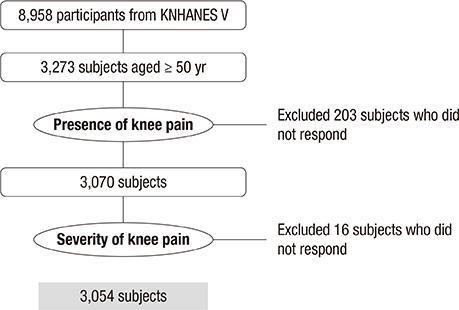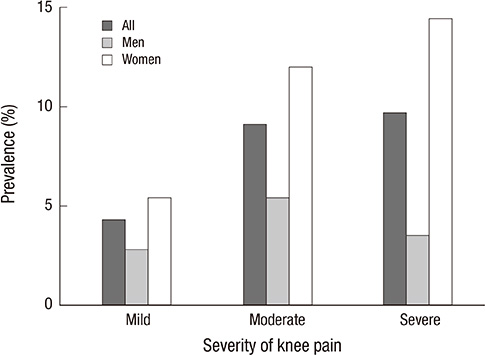J Korean Med Sci.
2013 Dec;28(12):1807-1813. 10.3346/jkms.2013.28.12.1807.
Knee Pain and Its Severity in Elderly Koreans: Prevalence, Risk Factors and Impact on Quality of Life
- Affiliations
-
- 1Seoul Madi Spine and Joint Clinic, Goyang, Korea.
- 2Joseph Madi Spine and Joint Clinic, Incheon, Korea.
- 3Department of Preventive Medicine, College of Medicine, Jeju National University, Jeju, Korea. suy0202@jejunu.ac.kr
- KMID: 1779424
- DOI: http://doi.org/10.3346/jkms.2013.28.12.1807
Abstract
- This study investigated the epidemiology (prevalence, risk factors, and impact on quality of life) of knee pain and its severity in elderly Koreans. The subjects (n=3,054) were participants aged > or =50 yr from the fifth Korea National Health and Nutrition Examination Survey, conducted in 2010. Knee pain was defined as pain in the knee lasting > or =30 days during the most recent 3 months; severity was categorized as mild, moderate, or severe. EQ-5D was used to measure quality of life. The prevalence of knee pain was 23.1% (11.7% in men, 31.9% in women). The prevalences of mild, moderate, and severe knee pain were 4.3%, 9.1%, and 9.7%, respectively (2.8%, 5.4%, and 3.5% in men and 5.4%, 12.0%, and 14.4% in women). Old age, female gender, a low level of education, a manual occupation, obesity, and radiographic osteoarthritis were risk factors for knee pain, and were associated with increased severity of knee pain. Excluding men with mild knee pain, people with knee pain had significantly lower quality of life than those without knee pain. Early interventional approaches are needed to reduce the medical, social, and economic burden of knee pain in elderly Koreans.
Keyword
MeSH Terms
-
Age Factors
Aged
Asian Continental Ancestry Group
Female
Humans
Logistic Models
Male
Middle Aged
Obesity/complications
Odds Ratio
Osteoarthritis, Knee/complications/epidemiology/radiography
Pain/*epidemiology/etiology
Prevalence
*Quality of Life
Questionnaires
Republic of Korea
Risk Factors
Severity of Illness Index
Sex Factors
Figure
Cited by 3 articles
-
Clinical Guidelines for Drug-induced Peptic Ulcer, 2020 Revised Edition
Moon Kyung Joo, Chan Hyuk Park, Joon Sung Kim, Jae Myung Park, Ji Yong Ahn, Bong Eun Lee, Jeong Hoon Lee, Hyo-Joon Yang, Yu Kyung Cho, Chang Seok Bang, Beom Jin Kim, Hye-Kyung Jung, Byung-Wook Kim, Yong Chan Lee
Korean J Gastroenterol. 2020;76(3):108-133. doi: 10.4166/kjg.2020.76.3.108.Prevention of Peptic Ulcer Associated with Aspirin and Antiplatelet Agent
Ji Yong Ahn
Korean J Gastroenterol. 2020;76(5):238-241. doi: 10.4166/kjg.2020.140.Factors Associated with Knee Pain with Different Grades of Knee Osteoarthritis among Korean Adults Aged 50 Years or More
Eun Young Choi, Min Jeong Kim
Korean J Health Promot. 2016;16(3):145-152. doi: 10.15384/kjhp.2016.16.3.145.
Reference
-
1. Nguyen US, Zhang Y, Zhu Y, Niu J, Zhang B, Felson DT. Increasing prevalence of knee pain and symptomatic knee osteoarthritis: survey and cohort data. Ann Intern Med. 2011; 155:725–732.2. Kim IJ, Kim HA, Seo YI, Jung YO, Song YW, Jeong JY, Kim DH. Prevalence of knee pain and its influence on quality of life and physical function in the Korean elderly population: a community based cross-sectional study. J Korean Med Sci. 2011; 26:1140–1146.3. Cho HJ, Chang CB, Jung JW, Seong SC, Kim TK. Prevalence of radiographic knee osteoarthritis in elderly Koreans. J Korean Knee Soc. 2009; 21:223–231.4. Kim I, Kim HA, Seo YI, Song YW, Jeong JY, Kim DH. The prevalence of knee osteoarthritis in elderly community residents in Korea. J Korean Med Sci. 2010; 25:293–298.5. Peat G, McCarney R, Croft P. Knee pain and osteoarthritis in older adults: a review of community burden and current use of primary health care. Ann Rheum Dis. 2001; 60:91–97.6. Creamer P, Lethbridge-Cejku M, Hochberg MC. Factors associated with functional impairment in symptomatic knee osteoarthritis. Rheumatology (Oxford). 2000; 39:490–496.7. Anttila T, Helkala EL, Viitanen M, Kåreholt I, Fratiglioni L, Winblad B, Soininen H, Tuomilehto J, Nissinen A, Kivipelto M. Alcohol drinking in middle age and subsequent risk of mild cognitive impairment and dementia in old age: a prospective population based study. BMJ. 2004; 329:539.8. Takahashi M, Naito K, Abe M, Sawada T, Nagano A. Relationship between radiographic grading of osteoarthritis and the biochemical markers for arthritis in knee osteoarthritis. Arthritis Res Ther. 2004; 6:R208–R212.9. Kim BS. Education and quality control program of professional surveyers for osteoarthritis examination of the fifth Korea National Health and Nutrition Examination Survey (KNHANES V-1). Cheongwon: Korea Centers for Disease Control and Prevention;2010. p. 1.10. Jones KR, Fink R, Hutt E, Vojir C, Pepper GA, Scott-Cawiezell J, Mellis BK. Measuring pain intensity in nursing home residents. J Pain Symptom Manage. 2005; 30:519–527.11. Rabin R, de Charro F. EQ-5D: a measure of health status from the EuroQol Group. Ann Med. 2001; 33:337–343.12. Schrag A, Selai C, Jahanshahi M, Quinn NP. The EQ-5D: a generic quality of life measure-is a useful instrument to measure quality of life in patients with Parkinson's disease. J Neurol Neurosurg Psychiatry. 2000; 69:67–73.13. Gameroff MJ. Using the proportional odds model for health-related outcomes: why, when, and how with various SAS® procedures. accessed on 1 September 2013. Available at http://www2.sas.com/proceedings/sugi30/205-30.pdf.14. Miranda H, Viikari-Juntura E, Martikainen R, Riihimäki H. A prospective study on knee pain and its risk factors. Osteoarthritis Cartilage. 2002; 10:623–630.15. Wijnhoven HA, de Vet HC, Picavet HS. Prevalence of musculoskeletal disorders is systematically higher in women than in men. Clin J Pain. 2006; 22:717–724.16. Felson DT, Anderson JJ, Naimark A, Hannan MT, Kannel WB, Meenan RF. Does smoking protect against osteoarthritis? Arthritis Rheum. 1989; 32:166–172.17. Amin S, Niu J, Guermazi A, Grigoryan M, Hunter DJ, Clancy M, LaValley MP, Genant HK, Felson DT. Cigarette smoking and the risk for cartilage loss and knee pain in men with knee osteoarthritis. Ann Rheum Dis. 2007; 66:18–22.18. Maxwell JR, Gowers IR, Moore DJ, Wilson AG. Alcohol consumption is inversely associated with risk and severity of rheumatoid arthritis. Rheumatology (Oxford). 2010; 49:2140–2146.19. Adamson J, Ebrahim S, Dieppe P, Hunt K. Prevalence and risk factors for joint pain among men and women in the West of Scotland Twenty-07 study. Ann Rheum Dis. 2006; 65:520–524.20. Creamer P, Lethbridge-Cejku M, Hochberg MC. Determinants of pain severity in knee osteoarthritis: effect of demographic and psychosocial variables using 3 pain measures. J Rheumatol. 1999; 26:1785–1792.21. Gill RS, Al-Adra DP, Shi X, Sharma AM, Birch DW, Karmali S. The benefits of bariatric surgery in obese patients with hip and knee osteoarthritis: a systematic review. Obes Rev. 2011; 12:1083–1089.
- Full Text Links
- Actions
-
Cited
- CITED
-
- Close
- Share
- Similar articles
-
- Prevalence of Knee Pain and Its Influence on Quality of Life and Physical Function in the Korean Elderly Population: A Community Based Cross-Sectional Study
- Factors Associated with Knee Pain with Different Grades of Knee Osteoarthritis among Korean Adults Aged 50 Years or More
- Prevalence of Radiographic Knee Osteoarthritis in Elderly Koreans
- Effects of Electrical Stimulation Therapy on Chronic Knee Pain, Exercise Self-Efficacy, and Quality of Life in Korean Elderly Women
- Prevalence and Risk Factor of Neck Pain in Elderly Korean Community Residents




